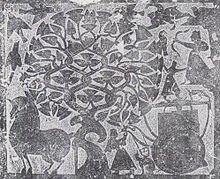Wu Family Shrines
You can help expand this article with text translated from the corresponding article in Chinese. (October 2023) Click [show] for important translation instructions.
|


The Wu Family Shrines (Chinese: 武氏祠), of which the Wu Liang Shrine (武梁祠) is the best known, was the family shrine of the Wu clan of the Eastern Han dynasty. The shrines contain a vast amount of relief carvings.[1]
Three walls of Wu Liang's shrine were still standing as late as the 11th century, which is the reason that the site of all the family shrines are often called after him.[2] The shrine to Wu Liang (78-151 AD) was built in 151 AD in what is now Jiaxiang County of southwestern Shandong province.[1]
References[edit]
- ^ a b Wu, Hung (1989). The Wu Liang Shrine: The Ideology of Early Chinese Pictorial Art. Stanford: Stanford University Press. pp. xvi–xix. ISBN 9780804715294.
- ^ "Rubbing of stone relief from the offering shrines of Wuliangci of the Han dynasty. Traditional grouping Wu Liang Group 3". Art Gallery of New South Wales. Retrieved 31 May 2017.
External links[edit]
Wikimedia Commons has media related to Wu family shrines.
- Barbieri, Anthony (2019). Virtual Tour of Wuzhai Shan Site, 2nd Century CE (v. 2.0). University of California, Santa Barbara.
